Xian Tours
Beijing Tours
China Tour Packages
About
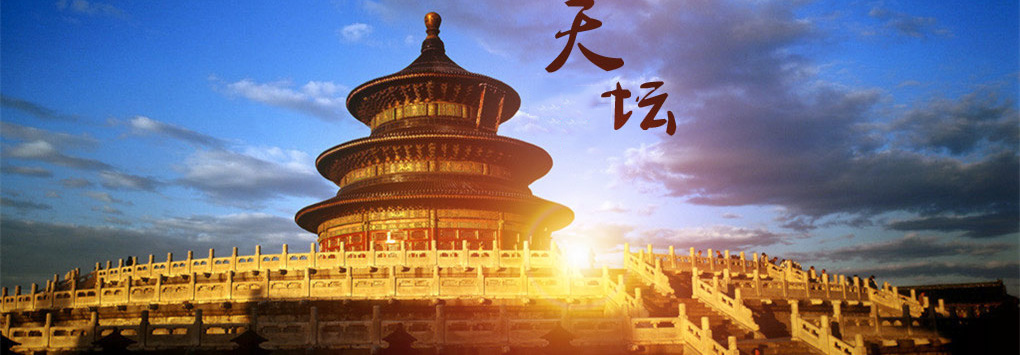
The Temple of Heaven, covering an area of 2,730,000 sq meters, is four times larger than the Forbidden City. It was used to hold memorial ceremonies for the God during the Winter Solstice Festival and to pray for a good harvest in the first month of the lunar year by the Emperors in the Ming and Qing dynasties. As the largest existing structure for sacrifices to heaven, Temple of Heaven has played a significant role in the whole architectural world for its rigorous layout, peculiar structure and magnificent decorations.
The Temple of Heaven was built in the first half of the 15th century AD.  It is located in the royal gardens and surrounded by ancient pines and is primarily a well-preserved Altar building. No matter whether you look at the whole layout or the individual building, it reflects the relationship between heaven and the earth and the Emperors' unique role in this relationship. As an accumulation of the Chinese civilization, it brings ancient philosophy, history, mathematics, mechanics, aesthetics and ecology together.
It is located in the royal gardens and surrounded by ancient pines and is primarily a well-preserved Altar building. No matter whether you look at the whole layout or the individual building, it reflects the relationship between heaven and the earth and the Emperors' unique role in this relationship. As an accumulation of the Chinese civilization, it brings ancient philosophy, history, mathematics, mechanics, aesthetics and ecology together.
Shaped in a rectangular-ambulatory-plane layout, it consists of two altar walls which are divided into the inner altar and the outer altar. The southernmost wall is square symbolizing the earth, while the most northern wall is semi-circular and symbolises heaven. High in the north and low in the south meant high heaven and low earth, and also an orbicular sky and rectangular earth. The northern and southern ends of the altar are linked by a wide Danbi Bridge. From south to north, there is the Circular Mound Altar and Imperial Heavenly Vault which are cleverly designed and superbly constructed.
Covering an area of 2,730,000 sq meters, Temple of Heaven is about 1700m from west to east and 1600m from south to north, about 3 times larger than the Forbidden City. The main sacrificial building complexes are composed of the Circular Mound Altar and the Hall of Prayer for Good Harvests, surrounded by two layers of parapets resembling Chinese character “回”.
 The axial arrangement of the Circular Mound Altar in the south and the conically roofed Imperial Vault of Heaven echoes the ancient Chinese cosmogony tenet of “round heaven and rectangular earth”.
The axial arrangement of the Circular Mound Altar in the south and the conically roofed Imperial Vault of Heaven echoes the ancient Chinese cosmogony tenet of “round heaven and rectangular earth”.
There are only two gates in the west of outer altar, while inner altar has four gates built in all four directions. Besides the Circular Mound Altar and the Hall of Prayer for Good Harvests, there are two different building complexes - Palace of Abstinence and the Divine Music Administration. The Palace of Abstinence is actually a the special residence for emperors to fast before the grand sacrificial ritual. The Divine Music Administration is subordinated to Taichang Temple, specially responsible for performing the ritual music during the sacrifice. In the surroundings of the complexes planted about 4000 dark green pine and cypress trees, making the temple more solemn and respectful.
The Hall of Prayer for Good Harvests is a peculiar building with distinctly ethnic characteristics. Built on three levels of marble stone base, with a three up-contracted layers of dome-shaped canopy covered with blue glazed tiles and topped with gilt roof, and supporting wooden structure fashioned with enamel paintings, the whole complex’s different parts impose a strong color contrast, making the whole scene harmonious and interesting.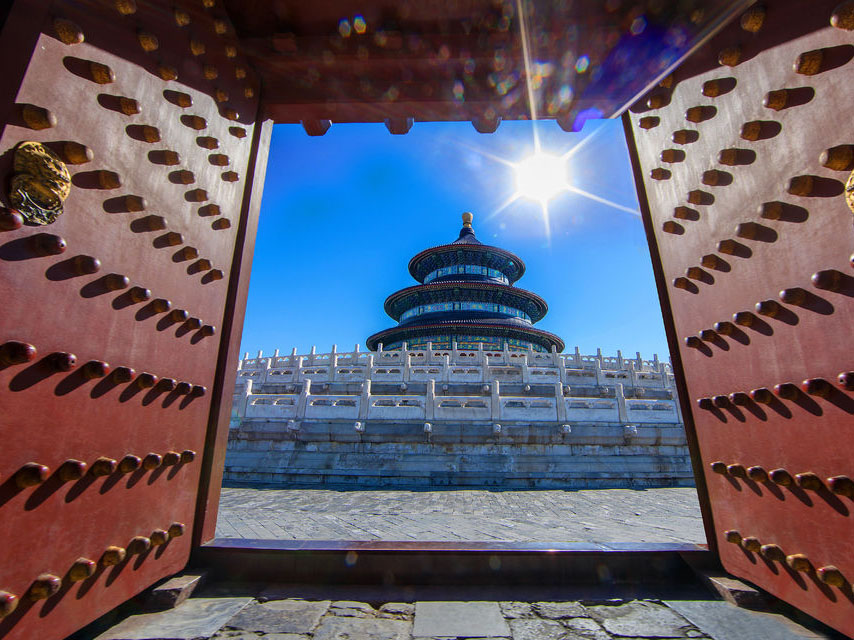
The Hall of Prayer for Good Harvests used to be the tallest building in Beijing and it’s absolutely magnificent. Originally built in the eighteenth year (1420) of the reign of the Ming Emperor Yongle, the Hall of Prayer of Good Harvests is 33m tall and 24.2m in diameter. Rather than an altar, it is more like a palace as the Hall of Great Enjoyment was built on its site by Emperor Jiajing. In Qing Dynasty, it was used for the ritual of praying of good harvest. In the sixteenth year of the reign of Emperor Qianlong, its ceilings were changed into blue tiles and golden tops. In 1889, the hall was burned down by a fire caused by lighting. The fragment smell of the sandal woods that used for the building spread miles and miles away. The rebuilding measures were made in several years and resulted in the current building.

Built in the ninth year (1530) of Jiajing Emperor in Ming Dynasty, the Imperial Vault of Heaven is a storeroom to keep all the materials needed for the ceremonies on the Round Altar like spirit tablets of the gods. It’s a arch wooden structure in circular shape, 19.5m high and 15.6m in diameter, with multiple eaves. Topped with blue tiles and golden peak, the whole palace looks very exquisite and elegant from the outside. Inside the palace, the dark green sunk panel decorated by the golden dragon in the center is a masterpiece of ancient Chinese architecture.

Three Echo Stone refers to the third stone of the imperial road in front of the Imperial Vault of Heaven. If one stand on this stone and claps his hands once, three echoes will be heard. The mystery lies in the location of the stone. It’s in the very center of the Echoing Wall, which means that the acoustic wave coming from here will be reflected by the eastern & western palace and the Echoing Wall, and then go back to the original spot. While, the distance of the two reflectors to the center are different, making three echoes possible.
Built in the same year of the Imperial Vault of Heaven, the  Circular Mound Altar is the raised dais for the Sacrificial Ceremony to the Heaven every winter solstice. Originally being only a circular platform of blue colored glaze, the Alar was extended in Qianlong Emperor’s reign. The blue color glaze was replaced by the white marble and the platform was paved by the blue stones. As odd numbers were sacrosanct in old China, the number nine, being the highest single-digit odd number and a happy coincidental homonym of Chinese character “久”(long life), was constantly related to the arrangements of tiers, stones, stairs and handrails. The repeated use of nine or nice multiples demonstrated the sovereign power of the heaven.
Circular Mound Altar is the raised dais for the Sacrificial Ceremony to the Heaven every winter solstice. Originally being only a circular platform of blue colored glaze, the Alar was extended in Qianlong Emperor’s reign. The blue color glaze was replaced by the white marble and the platform was paved by the blue stones. As odd numbers were sacrosanct in old China, the number nine, being the highest single-digit odd number and a happy coincidental homonym of Chinese character “久”(long life), was constantly related to the arrangements of tiers, stones, stairs and handrails. The repeated use of nine or nice multiples demonstrated the sovereign power of the heaven.
Built in eighteenth year (1420) of Emperor Longle,  the Palace of Abstinence is where emperors fast. The whole palace is protected by two layers of wall and moat. Inside the palace, there are Beamless Hall, Bedroom Hall, Stone Pavilion of Bronze Statue, Bell Tower, Duty House, and other buildings for etiquette, residence, service and guarding. Emperor needs to arrive at the Palace of Abstinence 3 days prior to the ceremony and abstain from all earthly pleasures like meat, alcohol, music, criminal law, condolence, illness, to show his utter piety and devotion.
the Palace of Abstinence is where emperors fast. The whole palace is protected by two layers of wall and moat. Inside the palace, there are Beamless Hall, Bedroom Hall, Stone Pavilion of Bronze Statue, Bell Tower, Duty House, and other buildings for etiquette, residence, service and guarding. Emperor needs to arrive at the Palace of Abstinence 3 days prior to the ceremony and abstain from all earthly pleasures like meat, alcohol, music, criminal law, condolence, illness, to show his utter piety and devotion.
Located in the west of the Temple of Heaven Park, the  Divine Music Administration is where musicians practice music for imperial ceremonies. It’s also praised as the institution of higher music and instrument learning in Ming and Qing Dynasties. Built in the same year of the Palace of Abstinence, the Divine Music Administration is comprised of many small halls, like Ningxi Hall, Xianyou Hall, Zhaoyi Institution, Muyi Institution, and Linglun Hall, some of which functioning as tea houses and medicine shops. Nowadays, there is a museum with various ceremonial music and instruments on display.
Divine Music Administration is where musicians practice music for imperial ceremonies. It’s also praised as the institution of higher music and instrument learning in Ming and Qing Dynasties. Built in the same year of the Palace of Abstinence, the Divine Music Administration is comprised of many small halls, like Ningxi Hall, Xianyou Hall, Zhaoyi Institution, Muyi Institution, and Linglun Hall, some of which functioning as tea houses and medicine shops. Nowadays, there is a museum with various ceremonial music and instruments on display.
Almost all the important ancient buildings of Beijing are located on the central axis, why isn’t the case with Temple of Heaven? According to I-ching, the southeastern side is the best spot to acquire sunlight and a special spot for imperial palace, making it the best location for offer sacrifice to heaven. This is why the temple of Heaven is built in the southeastern side of the Forbidden City.
If you look carefully, you will notice that there are doors in every side 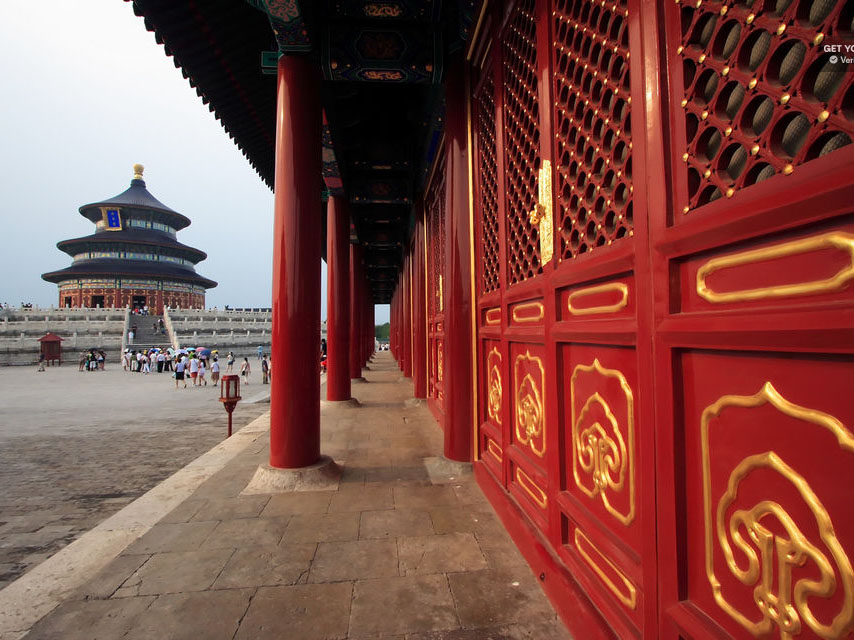 of the Hall of Prayer for Good Harvests. Why? To explain this, we have to go back to a Ming Dynasty emperor.
of the Hall of Prayer for Good Harvests. Why? To explain this, we have to go back to a Ming Dynasty emperor.
Emperor Wuzong Zhu Houzhao of Ming Dynasty died with no heir left, his cousin Zhu Houcong (Emperor Jiajing) was raised to inherit the throne, which was quite undeserved in certain sense. To prove that his throne was well deserved, Zhu Houcong called in his ministers to look for proofs from old records. He found out that the Temple of Heaven built by the Emperor Yongle was originally named Temple of Heaven and Earth, so he ordered three other temples, namely Temple of Earth, Temple of Sun, Temple of Moon, to be built in northern, eastern and western Beijing, in order to undertake part of the sacrificial function of the Temple of Heaven. He also requested the major building of the Temple of Heaven to be built in circular shape. When he designed the new Hall of Prayer for Good Harvests, he referred to the earliest legendary architecture for sacrifice “Ming Tang” (a unique building with windows all around to let air in). In the end, the new building named Da Xiang with doors all around was built.
3.Why isn’t there any roof for Circular Mound Altar?
The Circular Mound Altar is where emperor offer sacrifice to the heaven.  According to the historical records, the ceremony began at 4:15 a.m (seven quarters before the sunrise) in each winter solstice, which can be very cold for every royal members and ministers. Why isn’t any roof built on the altar?
According to the historical records, the ceremony began at 4:15 a.m (seven quarters before the sunrise) in each winter solstice, which can be very cold for every royal members and ministers. Why isn’t any roof built on the altar?
4.Why did Emperor lived in West-wing House?
As a residential palace for emperor, why was the Palace of Abstinence  built in the west side of the Temple of Heaven? Based on the Chinese Fengshui, the position of this palace is quite unlucky. Why did the emperor live here?
built in the west side of the Temple of Heaven? Based on the Chinese Fengshui, the position of this palace is quite unlucky. Why did the emperor live here?
5.Why are there eight stones in Seven Star Stones?
In the southeastern side of the Seventy-two Gallery are the Severn  Star Stones. However, there are actually eight stones here. Why?
Star Stones. However, there are actually eight stones here. Why?
There are two explanations. One is that those seven stones was set in Jiajing Emperor’s rule of Ming Dynasty, representing seven peaks of Taishan Mountain. After the establishment of Qing Dynasty, Emperor Qianling added a small stone to show that Manchu belongs to Huaxia Nationality.
The other saying is that those stones were arrayed exactly according to the Triones. As there is a small darker star nearby the the Triones, it was also counted by the ancient Chinese people.
6.How to walk on the Danbi Bridge?
Danbi Bridge is a north-south road connecting the Hall of Prayer for Good Harvests and Imperial Vault of Heaven.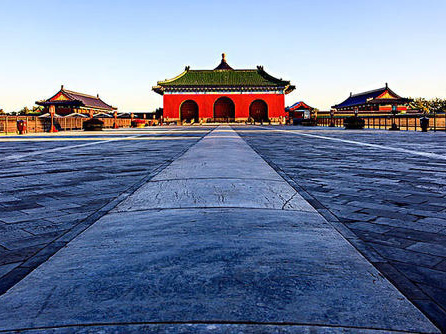 It’s about 3m high in the northern end and 1m high in the southern end, making it a gradual elevated road from south to north, indicating that the emperor is going upwards steps by steps. In fact, it’s praised as “The Path of Ascension”.
It’s about 3m high in the northern end and 1m high in the southern end, making it a gradual elevated road from south to north, indicating that the emperor is going upwards steps by steps. In fact, it’s praised as “The Path of Ascension”. In the middle of the bridge is a stone-paved road called “Sacred Road”, on its right is the “Royal Road” and on its left is the “Kingly Road”. During the grand ceremony, ministers walled on the Kingly Road, the Emperor walked on the Royal Road, while the eunuchs walk on the Sacred Road. The reason for this special arrangement was that the eunuchs held the memorial tablet of heaven, which means they actually represent the gods. While the emperor condescended to walk on the right.
Besides, emperor has to wash themselves and change their clothes before walking on the Danbi Bridge to show their great reverence. In Ming Dynasty, the emperors had to take off their shoes to show that no dust was to be brought to the divine altar.
Although common people were not allowed to access the Temple of Heaven, it’s available for visit nowadays with just a small amount of entrance fee. A morning tour here is highly recommended. Local residents enjoy their morning exercises here, running, cycling, singing, dancing, Taichi practicing, Kungfu practicing, calligraphy writing, kite flying, etc.. You can be part of any group to feel the hospitality of locals.
1.Opening hours: 6:00-21:00 (peak seasons); 6:30-21:00(low seasons);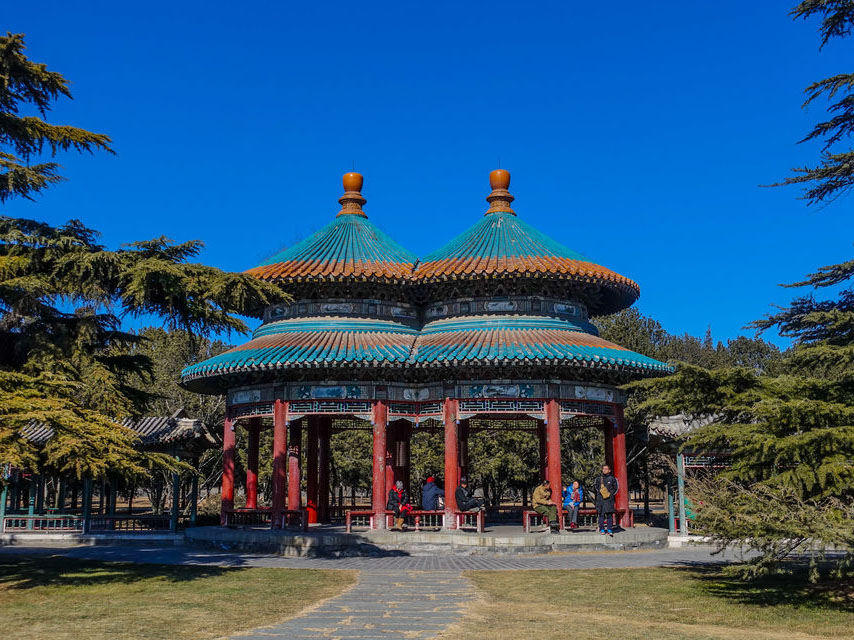
2.Tickets booking hours: 6:00-20:00 (peak seasons); 6:30- 20:00 (low seasons);
3.Joint tickets booking hours: 8:00 - 16:00 (peak seasons); 8:00 - 15:30 (low seasons);
1.Opening hours: 8:00 - 17:30 (peak seasons); 8:00 - 17:00 (low seasons);
2.Tickets booking hours: 8:00 - 16:30(peak seasons); 8:00 - 16:00 (low seasons);
3.North Divine Kitchen, North Animal Slaughter Hall, Palace of Abstinence: 9:00-12:00 and 13:00-16:00 of every Tuesday to Sunday.
Park Ticket in Peak Seasons (Apr. 1 - Oct.31): 15 RMB;
Park Ticket in Low Seasons (Nov.1 - Mar.31): 10 RMB;
Joint Tickets (including the park ticket, Hall of Prayer for Good Harvests, Echoing Wall, Circular Mound Altar) in Peak Seasons: 34 RMB;
Joint Tickets (including the park ticket, Hall of Prayer for Good Harvests, Echoing Wall, Circular Mound Altar) in low Seasons: 28 RMB;
By subway: Take Line 5 to Tiantan Dongmen Station and exit leave from Exit A;
North Gate: take bus 6, 34, 35, 36, 72, 106, 110 to Tiantan Beimen (North Gate);
South Gate: take bus 36, 53, 122, 525, 958, Rapid Transit Line 11 and Line 12 to Tiantan Nanmen (South Gate);
West Gate: take bus 2, 20, 36, 53, 120 to Tiantan Ximen (West Gate);
East Gate: take bus 6, 34, 35, 36, 39, 43, 60, 116, 128, 525, 623, 684 to Tiantan Dongmen (East Gate).
Beijing City Day Tour to Forbidden City and Temple of Heaven
Beijing City Day Tour to Forbidden City and Temple of Heaven
Copyright © 2019 Lily Sun China Tours International, Inc. Terms &conditions | Privacy Policy | Sitemap